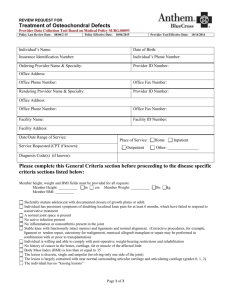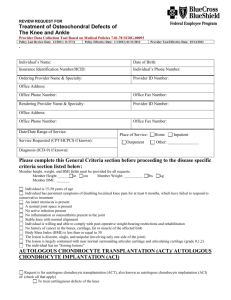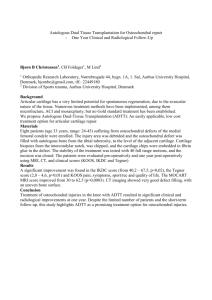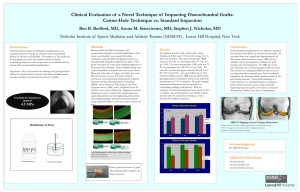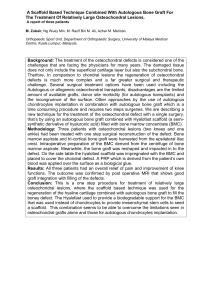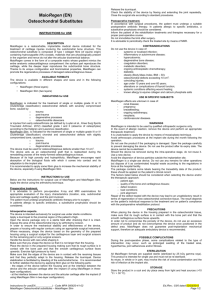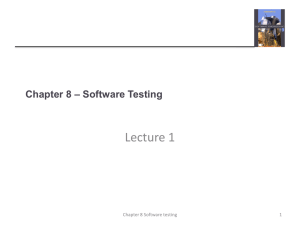Treatment for Osteochondral Defects
advertisement
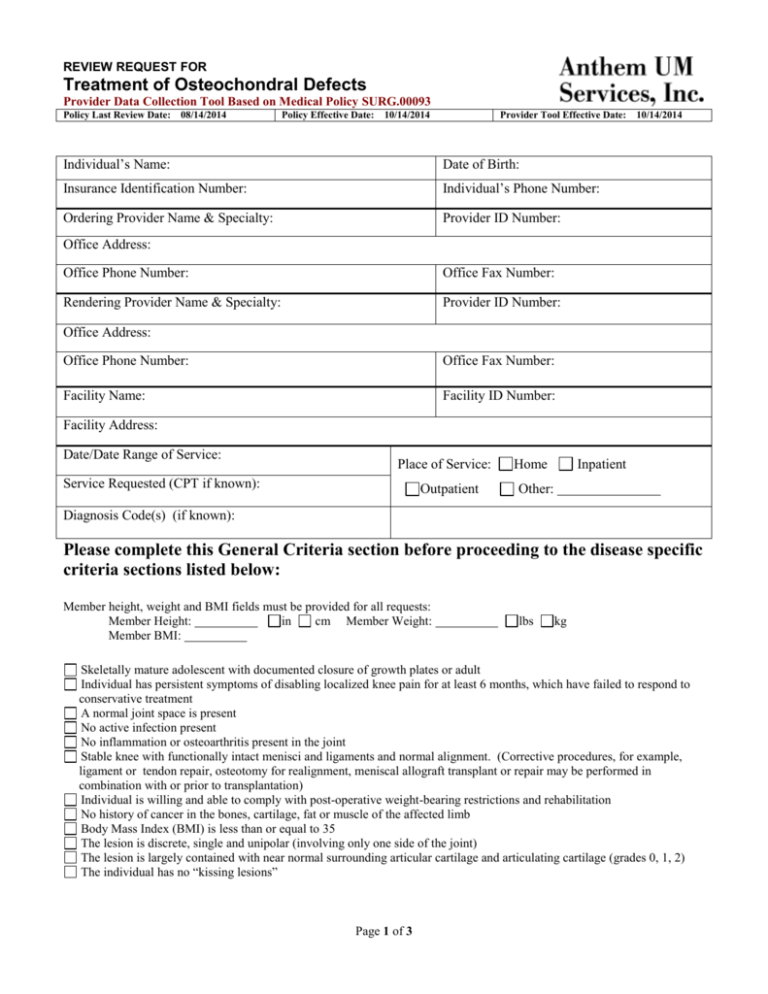
REVIEW REQUEST FOR Treatment of Osteochondral Defects Provider Data Collection Tool Based on Medical Policy SURG.00093 Policy Last Review Date: 08/14/2014 Policy Effective Date: 10/14/2014 Provider Tool Effective Date: Individual’s Name: Date of Birth: Insurance Identification Number: Individual’s Phone Number: Ordering Provider Name & Specialty: Provider ID Number: 10/14/2014 Office Address: Office Phone Number: Office Fax Number: Rendering Provider Name & Specialty: Provider ID Number: Office Address: Office Phone Number: Office Fax Number: Facility Name: Facility ID Number: Facility Address: Date/Date Range of Service: Place of Service: Service Requested (CPT if known): Outpatient Home Inpatient Other: Diagnosis Code(s) (if known): Please complete this General Criteria section before proceeding to the disease specific criteria sections listed below: Member height, weight and BMI fields must be provided for all requests: Member Height: in cm Member Weight: Member BMI: lbs kg Skeletally mature adolescent with documented closure of growth plates or adult Individual has persistent symptoms of disabling localized knee pain for at least 6 months, which have failed to respond to conservative treatment A normal joint space is present No active infection present No inflammation or osteoarthritis present in the joint Stable knee with functionally intact menisci and ligaments and normal alignment. (Corrective procedures, for example, ligament or tendon repair, osteotomy for realignment, meniscal allograft transplant or repair may be performed in combination with or prior to transplantation) Individual is willing and able to comply with post-operative weight-bearing restrictions and rehabilitation No history of cancer in the bones, cartilage, fat or muscle of the affected limb Body Mass Index (BMI) is less than or equal to 35 The lesion is discrete, single and unipolar (involving only one side of the joint) The lesion is largely contained with near normal surrounding articular cartilage and articulating cartilage (grades 0, 1, 2) The individual has no “kissing lesions” Page 1 of 3 REVIEW REQUEST FOR Treatment of Osteochondral Defects Provider Data Collection Tool Based on Medical Policy SURG.00093 Policy Last Review Date: 08/14/2014 Policy Effective Date: 10/14/2014 Provider Tool Effective Date: 10/14/2014 AUTOLOGOUS CHONDROCYTE TRANSPLANTATION (ACT) / AUTOLOGOUS CHONDROCYTE IMPLANTATION (ACI) Request is for Autologous chondrocyte transplantation (ACT), also known as autologous chondrocyte implantation (ACI) (Check all that apply) To treat cartilaginous defects of the knee To treat cartilaginous defects of the ankle (talus) Other (Please list): Individual has had an inadequate response to prior surgical therapy to correct the defect The size of the cartilage defect is greater than or equal to 1.5 square cm (i.e. length x width)** in total area Individual has no known history of allergy to the antibiotic Gentamicin Individual has no known sensitivities to bovine cultures The defect involves only the cartilage and NOT the subchondral bone Individual has osteochondritis dissecans which is associated with a bony defect 10 mm or less in depth and has failed prior conservative treatment Individual has lesions due to osteochondritis dissecans which is associated with a bony lesion of greater than 10 mm in depth which has undergone corrective bone grafting Individual’s condition involves a focal, full thickness, (grade III or IV) isolated defect involving the weight bearing surface of the medial or lateral femoral condyles or trochlear region (trochlear groove of the femur) caused by acute or repetitive trauma Other (Please list): OSTEOCHONDRAL ALLOGRAFT TRANSPLANTATION Request is for osteochondral allograft transplantation: (Check all that apply) To treat cartilaginous defects of the knee To treat cartilaginous defects of the ankle (talus) Other (Please list): Arthroscopic or magnetic resonance imaging (MRI) examination results detail the size, location and type of osteochondral defect The size of the cartilage defect is greater than or equal to 2 squared cm (i.e. length x width)** in total area Individual’s condition involves a focal, full thickness, (grade III or IV) isolated defect of the weight bearing surface of the medial or lateral femoral condyles or trochlear region (trochlear groove of the femur) caused by acute or repetitive trauma Other (Please list): Page 2 of 3 REVIEW REQUEST FOR Treatment of Osteochondral Defects Provider Data Collection Tool Based on Medical Policy SURG.00093 Policy Last Review Date: 08/14/2014 Policy Effective Date: 10/14/2014 Provider Tool Effective Date: 10/14/2014 OSTEOCHONDRAL AUTOGRAFT TRANSPLANTATION(OATS) / AUTOLOGOUS MOSAICPLASTY Request is for osteochondral autograft transplantation (OATS) or autologous Mosaicplasty: (Check all that apply) To treat cartilaginous defects of the knee To treat cartilaginous defects of the ankle (talus) Other (Please list): Arthroscopic or magnetic resonance imaging (MRI) examination results detail the size, location and type of osteochondral defect The size of the cartilage defect is between 1.0 to 2.5 squared cm (i.e. length x width)** in total area Individual’s condition involves a focal, full thickness, (grade III or IV) isolated defect involving the weight bearing surface of the medial or lateral femoral condyles or trochlear region (trochlear groove of the femur) caused by acute or repetitive trauma Other (Please list): OTHER Request is for Non-autologous mosaicplasty using resorbable synthetic bone filler materials (including but not limited to plugs and granules) to repair osteochondral defects of the knee or ankle Request is to use minced articular cartilage (whether synthetic, allograft or autograft) to repair osteochondral defects of the knee or ankle Other (Please list): ** Note: Square centimeters (square cm) is equal to the total surface area (length x width). Square cm can be calculated by multiplying the length in cm by the width in cm. This request is being submitted: Pre-Claim Post–Claim. If checked, please attach the claim or indicate the claim number I attest the information provided is true and accurate to the best of my knowledge. I understand that the health plan or its designees may perform a routine audit and request the medical documentation to verify the accuracy of the information reported on this form. _____________________________________________________________ Name and Title of Provider or Provider Representative Completing Form and Attestation (Please Print)* Date *The attestation fields must be completed by a provider or provider representative in order for the tool to be accepted Anthem UM Services, Inc., a separate company, is the licensed utilization review agent that performs utilization management services on behalf of your health benefit plan or the administrator of your health benefit plan. Page 3 of 3
